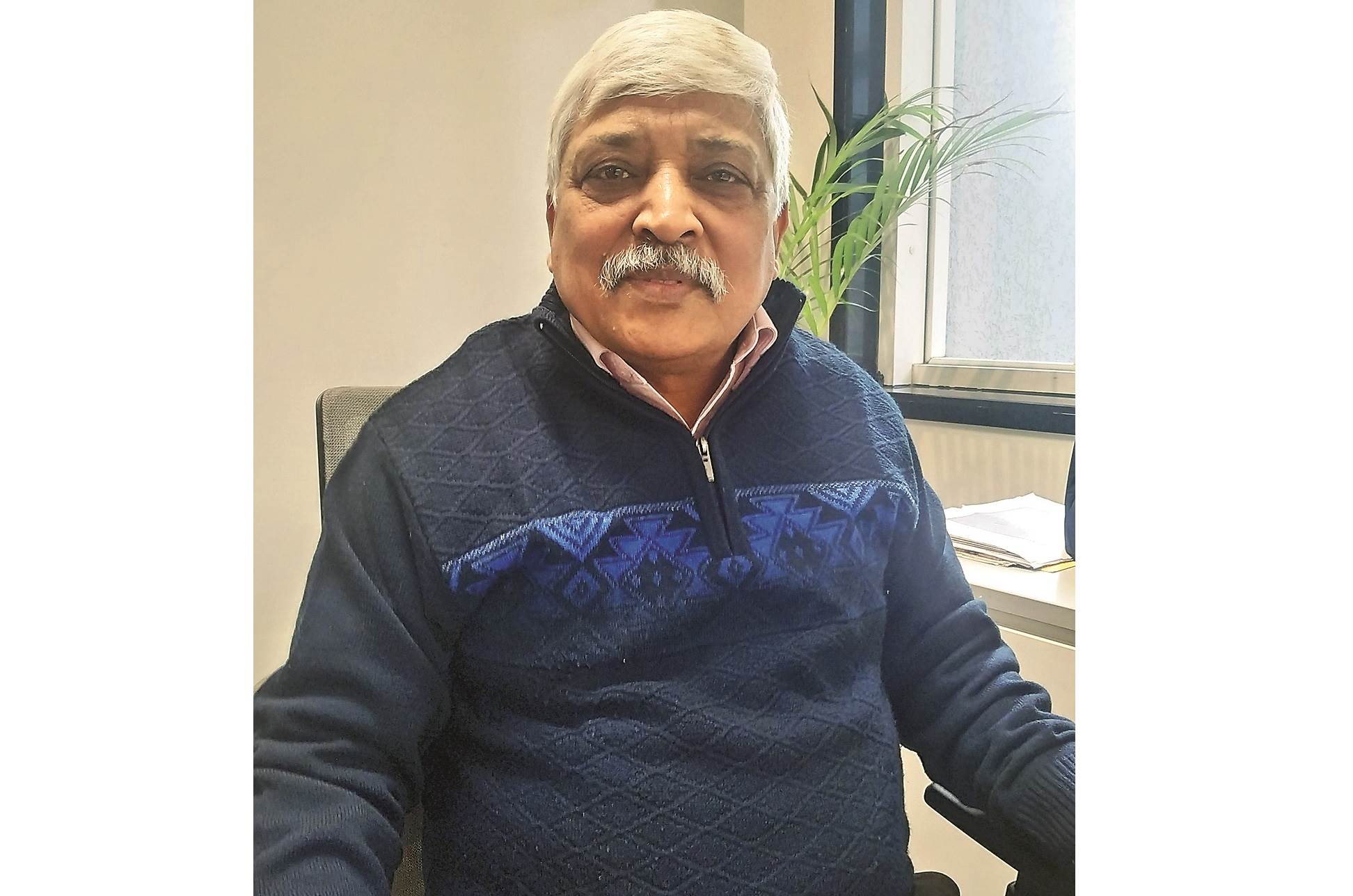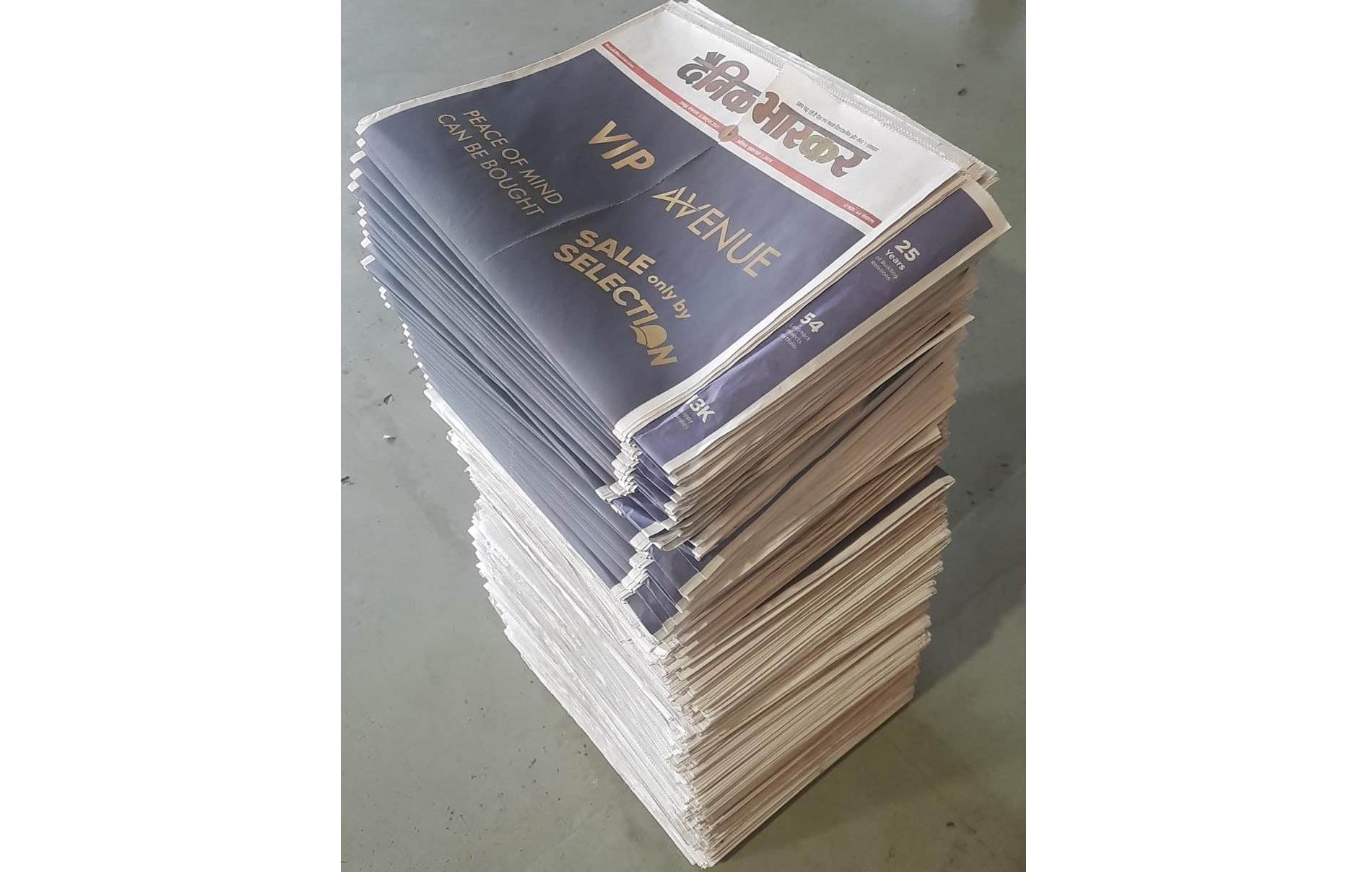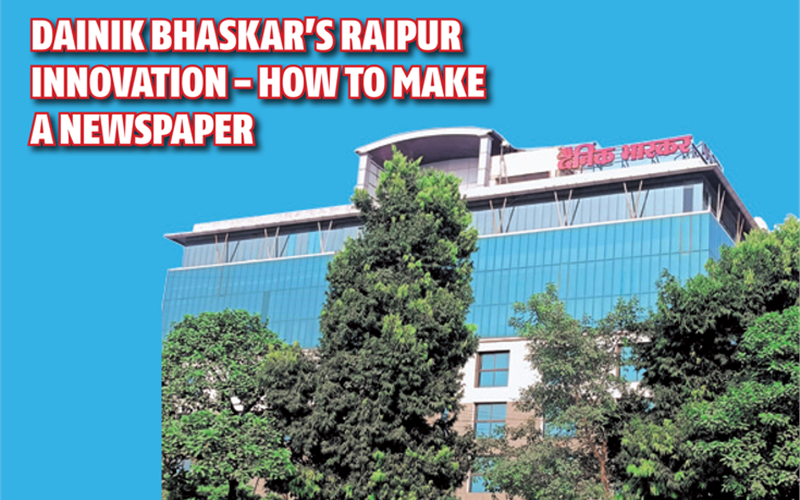Dainik Bhaskar’s Raipur innovation - How to make a newspaper - The Noel D'Cunha Sunday Column
It was a bumper issue, a 104-page newspaper, packed with innovation in both contents, advertisements and print.
In this conversation with PrintWeek, Devesh Singh, business head Chattisgarh and Dinesh Sharma, associate vice president production, discuss the print challenge, plus 33 years of Dainik Bhaskar in Raipur
Read on....
14 Nov 2021 | By Noel D'Cunha
Congratulations on the mega edition which deployed a gate-fold, inside jacket with book-mark and a flap.
Thank you.
How many months of planning did all this print innovation take?
The readers found the edition very innovative, as the experiment done with the pages was new for the readers. They found the idea very creative, thoughtful and unique. The readers have given the feedback that Dainik Bhaskar is the only print media who with their innovative and unique ideas creates the largest readership all around the country.
The last year has been tumultuous in terms of the pandemic, as a major newspaper publisher in the state of Chattisgarh how did you cope?
We took inspiration from other units of Dainik Bhaskar and had created a proper flow-chart dividing and assigning the roles and responsibilities to every team member. Firstly and foremost, we set the target that a minimum x-amount of single day billing should have to be done for the 33rd anniversary. After planning we did a proper working.
The main thought process was to create a history with the publication of the mega edition with a large number of innovations on a single day. It took us around a month after planning and implement these ideas. We thoughtfully presented ideas of innovation to our clients. Then we convinced them to collaborate with us. That’s how we were able to publish this mega edition with so many new innovations.

Has the Chhatisgarh market been good for you? Which cities have performed well?
After the pandemic, the situation was very critical but somehow, even during that difficult time we successfully managed to publish our all existing editions with running copies. We tried to have a conversation and discussions with the clients.
We motivated our customers during their tough times and encouraged them to take participation in everything we rolled out. We planned a vaccination drive page so that every client can collaborate with us and we urged them to publish ads with us by taking a pledge and urging the citizens of our nation to get vaccinated as soon as possible.
Good growth in Chhattisgarh state?
Chhattisgarh has undoubtedly come a long way in the 18 years since its inception.
One USP for print in Chhattisgarh state?
The USP of print in Chhattisgarh as well as across the Group is – reader-centric journalism. This makes Dainik Bhaskar the most trusted and most reliable media brand, which runs on its vision – to be the largest and most admired media brand enabling socio-economic change.
You have been in existence for 33 years in Raipur ... How did this journey begin?
We provide better reach and services than that of our rivals. As we are the leading newspaper of the state, with the highest readership we are known as the most trusted and credible brand of our field.
What kind of changes have you seen in Raipur in the past three decades?
After Chhattisgarh was formed, a decade ago, that is in 2000 with Raipur as its capital, the then district of Madhya Pradesh has been termed as the most developing and emerging city of the country. Raipur is an industrial hub not only for cities of Chhattisgarh but also for western Orissa, Jharkhand as well as Madhya Pradesh.

Describe the first edition you printed / published?
In Chattisgarh, the first edition was printed on 12 October 1988. It was called Navbhaskar. The title was changed to Dainik Bhaskar and the first edition with the new title was published on 12 October 1992. Today Dainik Bhaskar is the market leader among the five newspapers (Navbharat, Naidunia, Haribhoomi and Patrika) in Chhattisgarh.
Describe your most challenging newspaper project?
The Raipur mega edition of 104 pages can be called the most challenging newspaper project, as it is inclusive of various innovations done jointly by all the departments. Innovations (gatefold, inside jacket with bookmark and a flap) were done by the production department.
The ad sales department developed a segment advertisements concept containing Udyog Bhaskar, Property Bhaskar and DBS as supplements in the form of tabloid and broadsheets (24 page DB1, 24 page DB2, 10 page DB3, 28-page tabloid and 18-page broadsheet) in Raipur City.
What about content?
For content, we drew the theme – More Raipur, which is duly connected with the punch line for the smart city project of Raipur. It resembles the feel of Raipurian, hence for bringing out the proud feeling and Raipurian feeling, we took the concept to the next level by correlating the alphabets in the word RAIPUR (R-revolutionary, A – advanced, I-innovative, P-progressive, U-unique, R-republic). We have explained how More Raipur is now "More Raipur" by dedicating one page each for each of the letter.
The masthead is interesting ...
Yes. Another major experiment was on the masthead of Raipur. It was created with dhaan (grains), as Chattisgarh is called as dhaan ka katora (bowl of grains). Again this thought is connected with everyone’s life. We have written Dainik Bhaskar with nine varieties of different colours of dhaan. We have again brought the proud feeling by sharing the fact that Krishi Vishvidhayay in Raipur has discovered 24,000 varieties of dhaan and it is the worlds second-largest and India’s largest institute.

What are the things that the Raipur centre will be focussing on in 2022?
We are focussing on business growth.
Print-runs are becoming shorter by the day and consumption patterns have shifted over the last few years. Your view?
Yes, print orders and page levels have dropped in view of the ever-rising cost of newsprint and other consumables. A lot of advertisers have also shifted to the digital medium.
Dainik Bhaskar took the challenge to do give Raipurians a never-before product, accompanied with multiple innovations. We collected the content 15 days prior to the publication date and started printing two days in advance so that printing can be done sans panic. Hence with all the innovations, we have been able to print 104-page newspaper within the deadline.
Your Raipur factory is different from your other centres. How do you streamline your print work? How do you plan your job flow?
We have a big infrastructure of machines and other equipment giving us an edge over our competitors in terms of giving time flexibility for the latest coverage by the editorial. Our reach to market is much better than our rivals. We have a print facility at Raigarh. For other editions, we cater from Bilaspur.
How do you cope with quality expectations and the constant deadline pressure from your clients/marketing department?
We perform it through automation, with the least manual intervention for better print consistency.
When Girish Aggarwal attended the PrintWeek event in Mumbai, two years ago, he mentioned the possibility of DB factories producing books. Your long term view about the book market...
The books market is on the rise after the Covid 19 restrictions have been lifted. It has tremendous potential especially in tier-2 and tier-3 markets, where internet penetration is still very low. We are already doing book printing jobs from various print locations like Jaipur, Ahmedabad, Bhopal, Indore, and Sirhind among others.

Dinesh Sharma, associate vice president for production, Dainik Bhaskar
Many publishers prefer to use B-grade paper for their projects. Such papers cannot achieve the same quality as A-grade papers. Question is: how do you cope with issues about the quality of the paper that erodes process efficiency (especially in the printing stage: longer makeready, slower output etc)?
Because of the newsprint cost soaring with each passing day and its availability becoming a hindrance, we are also compelled to use the various grades of Indian newsprint paper. In such cases, we make possible tweaks to our system so that print quality is not compromised under any circumstances.
What sort of ERP — a cloud-based solution that facilitates the measurement of metrics and movement of information in real-time - do you rely on?
For editorial content planning, we use in-house software called Matix and the pages are designed using InDesign, as well as a cloud-based software called CPM (Cloud page making). We also deploy SAP for advertising, billing, financial as well as printing.
The toughest deadline you have had to execute?
The toughest deadline for the mega edition of 104-pager newspaper was to deliver the newspaper to the end-consumer, that is, the readers, and ad clients too. As we took the challenge to do give Raipurians a never-before product, it was accompanied by different innovations.
We collected the content 15 days prior to the publication date and started printing two days in advance so that printing can be done without much panic. Hence with all the innovations, we have been able to print 104-page newspaper within the deadline.
During the lockdown months, how did you set the direction and communicate to your team and help them stay abreast with you?
Keeping the entire workforce motivated was a big challenge. We managed it very efficiently by calling them in small groups, providing them with all facilities, We had a few key members on standby to meet any last-minute emergency. We sanitised the entire infrastructure virtually on daily basis. All Covid protocols were followed meticulously by everyone entering the plant.

Devesh Singh, business head, Chattisgarh, Dainik Bhaskar
You print innumerable types of newspaper editions. Please share with us what is transpiring in the newspaper space in the other centres of Chhattisgarh.
We work on a pull-out model – a piece of separate 4-pager city news. Each page is assigned a centre where the news of that place is published. The front page of the pullout features major happenings in the city. Hence the readers get the opportunity to read hyper-local content in the pullout as well as national or international content relating to politics, sports, business and the like, in the main newspaper.
How does a press such as yours operate differently in today's market, then you did in the past?
We have kept it very simple by being extremely cost-effective, promoting internal talent and a multitasking approach. We were and still are a reader- and advertiser-centric newspaper.
People speak of the price of a newspaper remaining constant in contrast to print inflation. You have modified the subscription slabs during the pandemic. How was it accepted?
Since Dainik Bhaskar‘s USP is its qualitative content, readers have accepted it at the current price. We hope to receive the same patronage even with higher prices in future.
What does the print industry in India need, to build on the strengths that we already have?
Advance infrastructure or a complete newspaper set-up at maximum locations pan-India. Going forward we should also share existing infrastructure with rival groups instead of making fresh investments.

How do you invest in human capital in terms of gender parity? Are middle and senior-level management able to take decisions independent of you?
We have vested enough powers in our employees and empowered them to take correct calls in the larger interest of the organisation. Our employees own the decisions without any fear of failure.
One thing about DB in Raipur no one knows.
We have a huge network team of reporters in 15 countries around the world and ten states of India where Dainik Bhaskar does not get printed.














 See All
See All